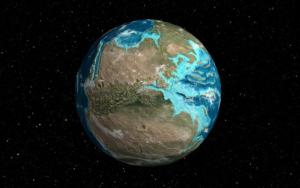The continents of the earth have entered and exited many times. And another merger to create the hypothetical supercontinent Pangea Proxima seems to be beginning.
In early 2019, a team from Curtin University (Perth – Australia) redrawn the violent history of the continents thanks to the evidence they have about Mirovoi – a swallowed super ocean.
The study recorded the oldest part of Earth’s land called Nuna , a supercontinent surrounded by a single super ocean that spans the rest of the globe, dating back 1.6-1.4 billion years. before. But the Earth suddenly shook: there seemed to be a monster lurking under the super ocean, swallowing it so slowly that the land was pulled towards being swallowed, tearing Nuna into many continents. To keep the balance, the monster did not forget to release several small oceans mixed with Nuna.

Image of the Earth 240 million years ago with the supercontinent Pangea reigning – (photo: Ancient Earth Globe).
Earth’s “monster” is actually a plate tectonic activity called “subduction” . Subduction occurs at the converging boundary of tectonic plates in the Earth’s outermost crust, causing one plate to move below the other, almost being swallowed up into the earth’s mantle. Conversely, somewhere on the globe, there will be other tectonic plates emerging from the depths at the same time.
900 million years ago, the subduction monster rose again, swallowing small oceans interspersed with continents, pulling the land together into a new supercontinent called Rodinia surrounded by the Mirovoi super ocean. 320 million years ago, the monster appeared again in the middle of the super ocean, but this time it was so strong that it not only tore through Rodinia, but pulled the torn parts in the opposite direction of the earth, forming a new supercontinent. is Pangea. 200 million years ago, subduction recurred in the middle of the super ocean, giving birth to 6 continents today.
Incidentally, right after the above study, two other studies published in May and June 2019 respectively suggested that the Earth had… started to submerge again.
The first work, led by the Dom Luiz Research Institute of the University of Lisbon (Portugal), discovered the peeling Earth’s crust off the coast of this country. A tectonic plate is shifting, pulling the land mass in Europe closer to Canada.
Another study from the Center for Earth Evolution and Dynamics at the University of Oslo (Norway) found that the earth’s deep water cycle is clearly out of balance: our planet is constantly “eating away”. a little water every year.
While it was only water that was eaten, scientists have linked it to the largest deepwater cycle imbalance that occurred 200 million years ago: when the supercontinent Pangea was torn apart by subduction. At that time, the Earth released parts of the ocean it swallowed, but it also reduced a lot, causing the global water level to drop by up to 130 meters.
The aforementioned groups of scientists all believe that the above events may be evidence that the earth “shudders” again, preparing to unite the continents into the legendary Pangea Proxima . But you shouldn’t worry too much about it causing something in your life. Because supercontinent formation is extremely slow . If Pangea Proxima is indeed being born, it would take at least 50 million years to form, too long for the history of any species that has ever existed on Earth.

